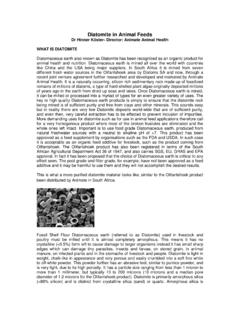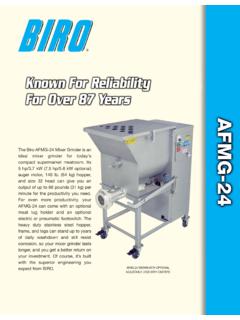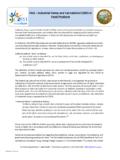Transcription of Selenium and Selenium Yeast Use in Feed
1 Selenium and Selenium Yeast Use in feed Selenium , long known for its toxic effects, only became recognized as an essential nutrient for livestock in 1957. The history of toxicity and question about Selenium being a possible carcinogen brought into play the Delaney Clause which increased the difficulty of FDA providing clearance for Selenium use in livestock feed . The initial approval came in 1973 after research demonstrated that nutritional levels should not be classified as carcinogenic and FDA concurred. This approval permitted the addition of sodium selenite and sodium selenate to complete feeds for growing chickens, swine and turkeys. Subsequent approvals followed for beef, dairy and sheep in 1978, laying chickens in 1979 and ducks in 1981.
2 In 1987, revisions were made to state that these complete feeds for beef and dairy cattle, sheep, chicken, swine, turkey and duck were to provide a supplemental level of Selenium up to ppm. Selenium Yeast Approval From 2000 to the present, several applications for use of Selenium Yeast have been reviewed by FDA. Current regulations allow for use of Selenium Yeast in complete feeds for chickens, turkeys, swine, beef and dairy cattle. Subsequently, FDA has reviewed the use of Selenium Yeast in other animal diets. These reviews led FDA to issue a letter stating that they will exercise enforcement discretion on Selenium use in horse, sheep and goat diets. These decisions apply to any firm that manufactures and markets Selenium Yeast within the specifications of FDA s Food Additive Regulation.
3 In 2007, CFR 21 was amended to allow the use of Selenium Yeast as a source of supplemental Selenium in limit-fed feed supplements and salt mineral mixes fed free-choice to beef cattle. This revision permits the use of Selenium Yeast in these types of feeds for beef cattle only. The three approved sources of supplemental Selenium are sodium selenite, sodium selenate and Selenium Yeast . In an attempt to set forth the requirements, the following explanation is provided. The applicable sections from the Code of Federal Regulations Title 21 (6) (b) through (h) provide the currently acceptable level of Selenium supplementation administered in feed . The regulations can be accessed here: The 2016 AAFCO definition for Selenium Yeast describes the uses and levels of Selenium Yeast currently accepted for use in animal feed products sold in Kentucky.
4 Selenium Yeast 1. Complete feeds for chickens, turkeys, swine, beef cattle, dairy cattle, bison, sheep, goats, llamas, alpacas, and horses at a level not to exceed ppm of Selenium , and to complete dog foods at a level not to exceed ppm of Selenium on a dry matter basis. 2. feed supplements for limit feeding for beef cattle, bison and horses at a level not to exceed an intake of 3 mg/hd/day. 3. feed supplements for limit feeding for goats, llamas and alpacas at a level not to exceed an intake of mg/hd/day. 4. Salt-mineral mixtures for free-choice feeding of beef cattle, bison, and horses up to 120 ppm in a mixture for free-choice feeding at a rate not to exceed an intake of 3 mg/hd/day.
5 5. Salt-mineral mixtures for free-choice feeding for goats, llamas and alpacas up to 90 ppm in a mixture for free-choice feeding at a rate not to exceed an intake of mg/hd/day. Selenium Yeast shall be incorporated into each ton of complete feed by adding no less than 1 lb of a premix containing no more than mg of added Selenium per pound. General Consideration for Distributing feed Containing Selenium and Selenium Yeast in KY The label for all commercial feeds must provide adequate directions for use to ensure that Selenium supplementation does not exceed permitted federal levels. Swine and Poultry The complete feed for swine and poultry may be supplemented up to ppm Selenium from all three approved sources of Selenium .
6 Protein supplements, base mixes, mineral and vitamin mixes and other products must have adequate directions for the purchaser to follow so that approved Selenium use is achieved. feed manufacturers also must ensure that feed products mixed at different rates to make complete feeds for different production phases such as swine starter or finisher provide adequate supplementation to meet the nutrient requirements for that production phase. Kentucky labeling regulations require a Selenium guarantee for swine feeds but not poultry feeds. Beef Cattle Complete feeds for beef cattle can be supplemented up to ppm Selenium from all three approved sources of Selenium in the total ration dry matter.
7 This approval is generally applicable to feed lot cattle while most Kentucky cattle are on pasture or fed stored roughage (hay/silage) and are not fed a complete ration. In this situation, beef cattle may be fed supplemental Selenium , either free-choice or limit fed at a level not to exceed an intake of 3 mg/hd/day. This may be achieved by limit-feeding of grain concentrates, protein supplements and free-choice salt-mineral mixtures. The highest recommended feeding rate for a product will establish the maximum Selenium level in the product. The following are examples of product intake necessary to provide 3 mg of supplemental Selenium at different levels: Selenium Supplementation at Varying feed Concentrations and Intakes: Selenium Level Intake to Provide 3mgs Example of Product Type ppm 22 lbs.
8 Grain Mix (limit-fed) ppm 11 lbs. Grain Mix (limit-fed) ppm lbs. Grain Mix (limit-fed) ppm lbs. Grain Mix (limit-fed) ppm lbs. Grain or Protein Supplement ppm lbs. Protein Supplement (limit-fed) ppm 6 oz. Free-choice or Mixing Mineral ppm 4 oz. Free-choice or Mixing Mineral ppm 3 oz. Free-choice or Mixing Mineral Selenium , when added, is a required guarantee on the label of beef mineral feeds but not complete beef feeds and supplements. Manufacturers are encouraged to consider a Selenium guarantee for all feeds to advise the purchaser of the level supplemented. This office encourages manufacturers to indicate in the feeding directions that this product, when fed at the recommended feeding rate of x (ounces or pounds), provides the maximum permitted Selenium supplementation of 3 mg/hd/day.
9 Dairy Cattle The Selenium approval for dairy cattle is based on ppm in the total ration dry matter intake from sodium selenite, sodium selenate or Selenium Yeast . As a rule of thumb, a grain concentrate will generally be fed up to 50% of the dry matter intake with forages constituting the other 50%. Based on this, a typical commercial dairy concentrate may guarantee up to ppm supplemental Selenium without any special labeling or feeding directions. Provided the Selenium level is above ppm then specific directions must be provided on the label to advise the dairyman how to feed in order to achieve the approved level of ppm in the total ration. Protein concentrates, supplements and mineral products that are mixed or limit-fed must have appropriate directions to provide for approved Selenium use.
10 Products that are mixed should be labeled with appropriate directions to achieve no more than ppm Selenium in the typical dairy concentrate or directions to achieve ppm in the total ration dry matter. Dairy Mineral Free-choice feeding of a mineral that contains Selenium is not approved in the Selenium regulations. Minerals for lactating dairy cattle are required to provide mixing directions and no free choice indication is permitted. It is recognized that non-lactating dairy cattle may receive little or no grain during this dry period. The only practical means of providing supplemental minerals to non-lactating dairy cows may be with a free choice mineral. Therefore, labeling for dairy mixtures may include free-choice feeding directions for non-lactating dairy cows in addition to mixing directions for lactating dairy cattle.







